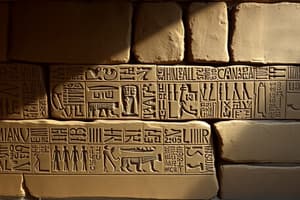Podcast
Questions and Answers
Cuneiform was primarily used by the Egyptians for record-keeping.
Cuneiform was primarily used by the Egyptians for record-keeping.
False (B)
The Code of Hammurabi consists of 282 laws that address aspects of daily life.
The Code of Hammurabi consists of 282 laws that address aspects of daily life.
True (A)
Writing first emerged in Mesopotamia around 3200 BCE as a complex system.
Writing first emerged in Mesopotamia around 3200 BCE as a complex system.
False (B)
The principle of 'an eye for an eye' is a famous aspect of the Code of Hammurabi.
The principle of 'an eye for an eye' is a famous aspect of the Code of Hammurabi.
Cuneiform evolved from drawings to a simple alphabetical system.
Cuneiform evolved from drawings to a simple alphabetical system.
The Code of Hammurabi was inscribed on a clay tablet.
The Code of Hammurabi was inscribed on a clay tablet.
Writing allowed for better administration of complex societies.
Writing allowed for better administration of complex societies.
The purpose of writing initially focused on literature and history.
The purpose of writing initially focused on literature and history.
Flashcards are hidden until you start studying
Study Notes
Invention of Writing
-
Origins:
- Emerged around 3200 BCE in Mesopotamia (modern-day Iraq).
- Developed from pictographs used for record-keeping.
-
Cuneiform:
- One of the earliest writing systems, created by the Sumerians.
- Used wedge-shaped marks on clay tablets.
- Evolved from simple pictographs to complex symbols representing sounds and concepts.
-
Purpose:
- Initially for administrative purposes (e.g., trade, taxation).
- Gradually expanded to include literature, laws, and history.
-
Impact on Society:
- Facilitated the administration of complex societies.
- Allowed for the preservation of knowledge and culture.
- Enabled communication across distances and generations.
Code of Hammurabi
-
Overview:
- One of the oldest deciphered writings of significant length in the world.
- Created around 1754 BCE by Hammurabi, the sixth king of the First Babylonian Dynasty.
-
Content:
- Consists of 282 laws covering various aspects of daily life, including trade, family, labor, and property rights.
- Famous for the principle of "an eye for an eye," establishing a system of justice.
-
Format:
- Inscribed on a basalt stele; presented in a clear and authoritative manner.
- Laws are structured into categories, with specific penalties for infractions.
-
Significance:
- Represents one of the earliest examples of a written legal code.
- Influenced future legal systems and concepts of justice.
- Demonstrates the role of writing in governance and societal order.
-
Cultural Legacy:
- Provides insight into Babylonian society, economy, and values.
- Highlights the transition from oral to written legal traditions.
Invention of Writing
-
Origins:
- Began around 3200 BCE in Mesopotamia, now known as modern-day Iraq.
- Evolved from early pictographs used primarily for record-keeping.
-
Cuneiform:
- One of the first writing systems developed by the Sumerians.
- Characterized by wedge-shaped marks made on clay tablets.
- Transitioned from simple pictographs to a complex system representing sounds and abstract concepts.
-
Purpose:
- Initially developed for administrative tasks like trade and taxation.
- Over time, usage expanded to encompass literature, law, and historical documentation.
-
Impact on Society:
- Played a vital role in managing complex societal structures.
- Enabled the preservation and transmission of knowledge and cultural practices.
- Facilitated communication across both time and distance.
Code of Hammurabi
-
Overview:
- Recognized as one of the oldest known writings of substantial length, dating back to around 1754 BCE.
- Commissioned by Hammurabi, who was the sixth king of the First Babylonian Dynasty.
-
Content:
- Contains 282 laws addressing issues related to trade, family relations, labor, and property rights.
- Notably includes the principle of "an eye for an eye," signifying a foundational aspect of justice.
-
Format:
- Inscribed on a basalt stele, designed to convey authority and clarity.
- Organized into categories, detailing specific penalties for breaches of the laws.
-
Significance:
- Represents one of the earliest written legal codes, paving the way for future legal frameworks.
- Influenced contemporary concepts of law and justice, illustrating the importance of written documentation in governance and societal regulation.
-
Cultural Legacy:
- Offers valuable perspectives into the socio-economic conditions and ethical values of Babylonian life.
- Marks a pivotal shift from oral traditions to formalized written legal practices.
Studying That Suits You
Use AI to generate personalized quizzes and flashcards to suit your learning preferences.




